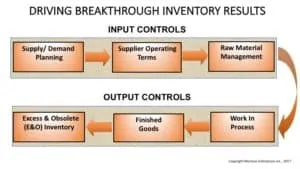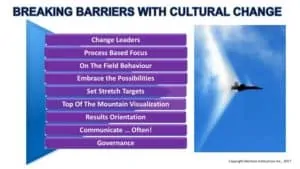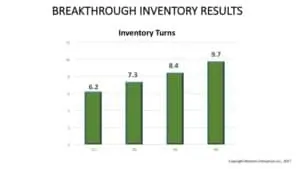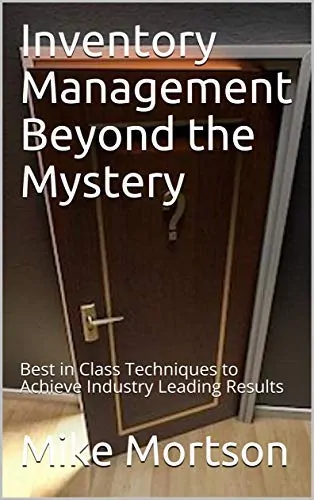We launched the Global Inventory Turnover Breakthrough project on April 1st. It was not a joke. Our challenge was to improve Inventory turnover from 6.3 turns to over 8.6 turns within the year. This was a level of achievement that the company had never before reached, let alone thinking about going from Worst to First.
But we had the Call to Action. Our Inventory turnover was perennially the worst in our industry. Our Inventory levels were consuming an enormous amount of cash as well as creating a lot of expense in carrying charges. And this had the effect of driving our Return on Invested Capital to very low, unattractive levels. Further there were ongoing complaints that even though we had a lot of inventory we never had all of the right material that was needed.
We had the motivation to turn this situation around. What we didn’t know is that we were about to make history and go from Worst to First!
The official launch was a conference call and involved everyone in Supply Chain and Process Management from all of our facilities around the world. While there were many other stakeholders that we would need to quickly reach out to we knew that tasking the Supply Chain team, the team that managed all supply/demand planning, all parameter management, and all purchase order placement/alteration, was of immediate importance.
We were taking the Holistic Approach as described in Inventory Turnover Breakthrough (Part 1) … Go Back To The Basics!. The challenge was too large and the time too short for us to do anything but tackle every angle at once. Further we had defined the main levers which control the rate of moving inventory in to the company, through the company, and out of the company (see blog Inventory Turnover Breakthrough (Part 2) – Define and Manage The Levers!). This determined which processes that had to be improved globally.

Further we had identified excellent leaders to lead the various Global Process teams. These people were truly great change agents who were able to work around the globe seamlessly and push the envelope of what could be accomplished.
We quickly followed up the launch conference call by travelling to all of the regions around the world, meeting with the teams from every facility. The face to face communication was crucial as we had to impart the seriousness and immediacy of our collective task, we had to address any resistance up front, we had to communicate the behaviours we needed in the culture, and we had to mobilize everyone around the challenge.
We employed the Attack on all Fronts approach (see our blog Hedge Your Bets For Success … Attack On All Fronts). As such we needed every Facility, every Customer team, and every Global Process team to understand our objective, to rally around us, and to drive the targets that we gave to each of them. If everyone played their part we had a great chance of meeting the challenge.
Additionally we began a weekly process of governance with each of the Facilities, each of the Process team leaders, and each of the Customer team leaders. Time was not on our side and we could not wait to see results only once a month and then react. We didn’t have the time to make any extensive changes in our I/T systems. We needed much more rapid feedback on what was working, what wasn’t working, and where we had to make course corrections, shape behaviours, and blast through obstacles and sacred cows.
This level of focus and on-the-field leadership allowed us, most importantly, to create the Cultural change (see our blog Inventory Turnover Breakthrough (Part 4) – Creating the Culture to Break Barriers!) that was at the core of what was needed in order to get the results we were looking for. The current situation was the result of years worth of behaviours, beliefs, processes and practices. We had to fundamentally change how people worked each and every day across the entire planet, and we had to do it fast.

The frequent reviews and governance allowed us to shape the behaviours needed to drive transformational change. We needed people to be results oriented. We needed them to make commitments and be held accountable to meet those commitments. We needed people to embrace the possibilities. And we needed people to believe in themselves and take risks. We had very smart employees and I didn’t believe for an instant that our competitors were really better than us. As such there was no reason we couldn’t surpass them and Change the Game!
As we proceeded through the coming weeks and months it was obvious that various elements of the project were proceeding at different paces. Some Process teams and some facilities got off to a fast start. Others took more time to get going due to inertia in the system and culture. This helped to inform where we needed to spend our time to ensure that everyone was in a position to hit their sub-targets.
But we had set the sub-targets such that we would over-achieve the goal if everyone did their part. The sum of the individual targets would far exceed our overall goal. By the end of the first quarter we had improved our Inventory turns by 1.1. This was a level of achievement which hadn’t been seen in a long time. It also moved us out of last place relative to our competition.
There had been a lot of success achieved in all of the Process, Facility and Customer teams. We communicated this success across the entire company, from the CEO on down. We highlighted the successes, communicated the next immediate steps that we needed to take, and we adjusted the sub-targets upward. And we went back on the road to meet everyone around the world to give them the same message face to face. This constant communication at all levels continued throughout the project. Momentum was building!
Over the coming months we continued the same on-the-field behavioural focus getting into extreme details and eliminating roadblocks, whether process based or behavioural, along the way. Friendly competition started building between the Process teams and Facilities to see who could improve the most. And everyone was, more than ever before, acutely aware of how important this project was to the success of the company. Our gun sights were set on catching the competition.
After the second quarter we improved our inventory turns by another 1.1 turns. Doing this 2 quarters in a row had never been done before in our company, and had rarely been done by any of our competitors. We moved from last place to being in third place as compared to our competitors. Further we had almost achieved our end of year goal 3 months earlier than planned. What had been a seemingly impossible goal only a few months before was now within our reach. The excitement and motivation were palpable.
Heading into the final quarter of the year we set our targets even higher. We went back on the road to ensure we continued to build on the momentum and to recognize the great results so far. Only 6 months before there was a lot of concern and skepticism about whether the goal could be accomplished. Now the paradigm and prevailing view was one of how far beyond the goal could we actually go.
From Worst to First!

We finished the year with a quarterly turnover improvement of 1.3 turns, our third consecutive quarter of improving turns by at least one full turn. This had never been done in the history of our industry. And when all of our competitors results for the quarter were published publicly the result was in: we had gone from being the worst in our industry in Inventory turnover to being Number One!

The pride in that accomplishment from everyone in the organization was absolutely incredible. To become the industry leader was phenomenal. We went from Worst to First. We had reduced inventory by hundreds of millions of dollars. We had reduced carrying charges, and improved profitability, by tens of millions of dollars. We had catapulted our Return on Invested Capital performance to also lead the industry. And we not only didn’t compromise a single customer delivery, but we increased Customer satisfaction as the quality of the Inventory was improved immensely.
We travelled around the world one more time meeting with all of the teams involved and recognizing all of them on their incredible accomplishment. Rarely had the organization had the opportunity to celebrate such a remarkable achievement. The pride and the happiness on everyone’s faces made all of the work worthwhile.
And because we focussed so intently on making process based improvements and changing the culture we had created sustainable results, which continued for several years thereafter.
On our journey from Worst to First we had truly Changed the Game!


 EBOOK HERE
EBOOK HERE